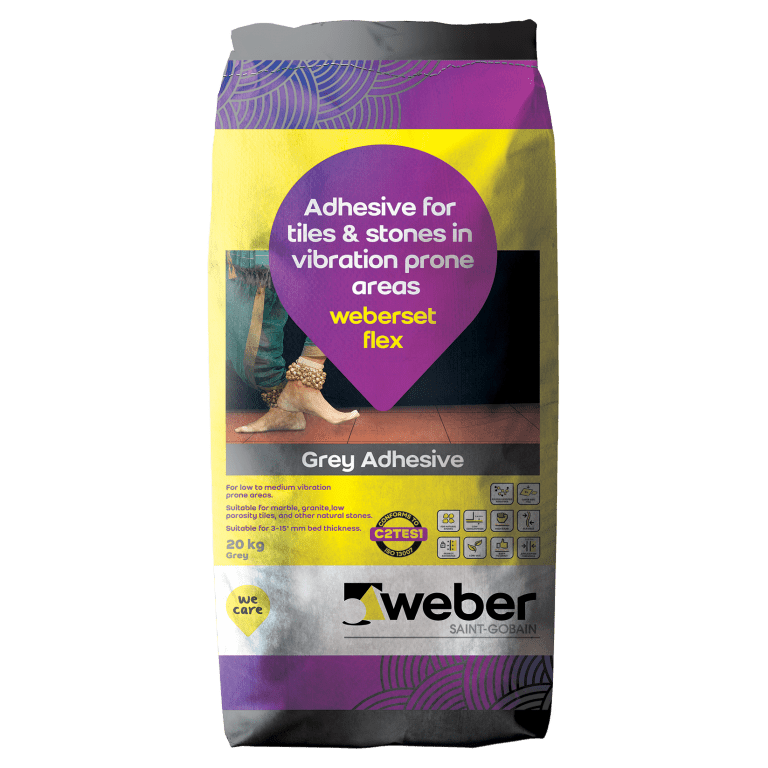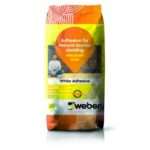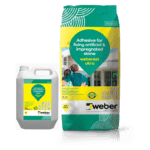Weberset Flex


Packaging
20 kg grey bag | 20 kg white bag
Adhesive for fixing tiles and stones in vibration prone areas
Ready to mix | Self curing | Easy to use | High compressive strength | Good coverage | Tile on tile application | High bond strength | Submerged conditions | Wall cladding | Heavy duty applications | Single component product | Low prorosity tiles | Imparts flexibility | High durability | Low VOC
Support
Wall, Floor
Weberset flex is a flexible, highly polymer modified, high performance, thin-set adhesive, for tiles, mosaics and stones, on a variety of substrates, which are prone to vibration. It is suitable for both vertical and horizontal application, in indoor as well as outdoor use. It is supplied as a dry mix mortar, to which water needs to be added before application.
- Flexible adhesive, which allows it to sustain low to medium vibration in the substrate.
- Suitable for Internal as well as external use.
- Highly polymer-modified provides high structural adhesion, which allows to be used on a variety of substrates, for fixing a variety of tiles and stones.
- Can be used for new construction, as well as for renovation over existing floors/facades.
- Long open time.
- Prolonged and easy workability.
- Low VOC – for healthy living. • No Hacking of substrate required to achieve the required bonding.
- Self-curing properties, which allows for no-hassle application, with minimum labour.
- The free-flowing product makes it easier to mix and apply.
- No-sag formula: allows for hassle-free application on vertical walls, without any slippage.
- Water-resistant, making it suitable for swimming pools, bathrooms, kitchen, saunas and spa.
- Sustains heat ageing, making it ideal for high-temperature locations for outdoor use, and also for hot temperature applications, like Jacuzzi, sauna etc.
- No shrinkage, prevents debonding and gives
- Do not use on wet screed or plaster. The surface must be fully cured.
- Do not use on gypsum plaster or boards, fibre cement boards, or other drywall partitions.
- Can only be used on cementitious waterproofing. Do not use on epoxy or polyurethane waterproofing.
- Do not use for Installing glass tiles or metal tiles. Use only Weber bond poxy, for fixing glass and metal tiles.
- Do not use on metal, rubber, plastics, vinyl, linoleum surface, painted substrates. Contact weber representative for fixing these.
- Do not use on surfaces subject to heavy vibrations. Use Weberfix drywall for areas subjected to heavy vibrations.
- Do not use for fixing artificial stone or impregnated stone. Use Weberset ultra for the same.
Weberset Flex Related Products
-

 weberset plus-white
weberset plus-whiteAdhesive For Window Framing, Tile Cladding, Natural Stone Flooring: Weberset plus-white is a polymer modified cementitious tile adhesive used for fixing vitrified tiles and natural stones on wall and floor, for internal as well as external areas. It has been specially modified to give high bond with natural stone, even when used at high bed thickness, making it appropriate to be used on window sill/jams.
-

 weberset firm
weberset firmAdhesive For Fixing Natural Stones On Wall And Floor: Weberset firm is a polymer modified cementitious tile adhesive used for fixing all types of tiles and natural stones like marble, granite on the wall and floor. For internal and external floor and wall areas, suitable for marble, granite, low porosity tiles and stones.
-

 weberset ultra
weberset ultraAdhesive For Fixing Artificial And Impregnated Stone: Weberset ultra is a two-component high performance modified adhesive for fixing impregnated stone, tile and large format tile & stones where nominal to moderate substrate movement is expected. For internal and external floor and wall areas, for fixing tiles, natural composite and impregnated stones.
